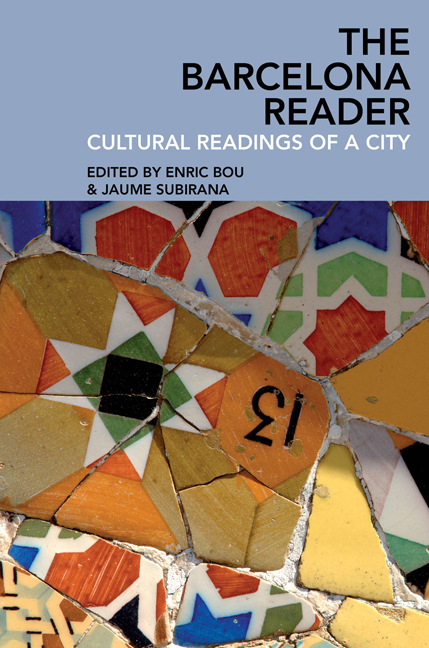Book contents
- Frontmatter
- Contents
- List of illustrations
- Notes on contributors
- Introduction: Barcelona: Cultural readings of a city
- I City, history, and territory
- 1 Barcelona: The siege city
- 2 Barcelona as an adaptive ecology
- 3 A present past, Barcelona street names, from Víctor Balaguer to Pasqual Maragall
- 4 ‘The asylum of modern times’: Barcelona and Europe
- 5 A fragile country
- II City and society
- III Art, architecture, and the city
- IV The Olympics and the city
- V Literature, cinema, and the city
2 - Barcelona as an adaptive ecology
from I - City, history, and territory
- Frontmatter
- Contents
- List of illustrations
- Notes on contributors
- Introduction: Barcelona: Cultural readings of a city
- I City, history, and territory
- 1 Barcelona: The siege city
- 2 Barcelona as an adaptive ecology
- 3 A present past, Barcelona street names, from Víctor Balaguer to Pasqual Maragall
- 4 ‘The asylum of modern times’: Barcelona and Europe
- 5 A fragile country
- II City and society
- III Art, architecture, and the city
- IV The Olympics and the city
- V Literature, cinema, and the city
Summary
[Barcelona] as a successful adaptive ecology […] example of an urban development where the visionary postulation of a city fit for the future tallied with a corresponding level of technical invention and achievement. […] limit[ing] the risk of the divide between design speculation and material capability. (Marc Burry 2013: 316)
As Mark Burry's statement in the quotation above, Barcelona fits in the concept of ‘adaptive ecology’ as defined by Theodor Spiropoulos. This is a ‘model of urbanism’ corresponding to the fact that ‘recent architecture has found itself having to cope with new social and cultural complexities that demand networked systems that are time-based, reconfigurable and evolutionary’, that is to say ‘a notion of architecture that looks towards designing systems that seek higher ordered goals emerging through an intimate correlation of material and computational interaction’ (Burry 2013: 3).
The expression ‘Barcelona Model’ has been promoted by the local tourist boosters helped by some scholars and takes profit of the fact that Barcelona can be considered a ‘model of urbanism’ deserving the title of ‘adaptive ecology’ because its form and urban system have been able to correspond to the increasingly complex cultural and social realities of contemporary cities. Architecture and modern urban design have shaped Barcelona's urbanism, perhaps because this city assumes that one of the ‘higher ordered goals’ to which the designing systems of architecture should respond is ‘territoriality’. With that apparent tautology I mean that for a long time Barcelona's plans and projects have coped with ‘social and cultural complexities’ to produce the present urban territory as its outcomes, allowing high quality in buildings and urban spaces. This resulted from a widely shared consciousness among citizens of a common territory, as well as the urban projects mentioned above.
Crucial modern plans and projects for Barcelona had always been achieved by recently invented new systems of representation that changed the way of seeing the world and new systems for materially producing that vision. It is a general assumption that the Renaissance was an outstanding example of a time of unprecedented achievement, when humanism and the invention of perspective led to the emergence of the architect as a figure specialized in imagining and designing buildings and spaces, and providing technical explanations to the master masons responsible for realizing them.
- Type
- Chapter
- Information
- The Barcelona ReaderCultural Readings of a City, pp. 43 - 70Publisher: Liverpool University PressPrint publication year: 2017



